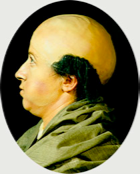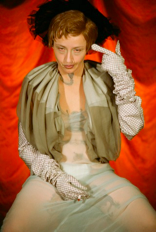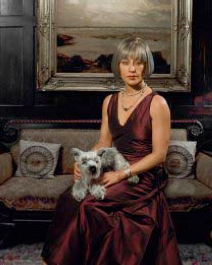CINDY SHERMAN UNTITLED: TRANSCENDENCE AND TRANSFORMATION
CINDY SHERMAN UNTITLED: TRANSCENDENCE AND TRANSFORMATION Museum of Modern Art, February 26–June 11, 2012

From an early age, dressing up in their mother’s clothes, girls are encouraged to enhance their appearance in order to attract men and the world at large, often to the extent of self-betrayal. At the same time, the idea of such endeavors as the beleaguered expression of the oppressed doesn’t really tell the whole story. Play has the ability to defuse the so-called oppressor’s grip on identity and, of course, there is power in sexual magnetism. It’s in this sense that I prefer the word “play” over “work” in relation to Cindy Sherman.
For four decades Sherman has been instructing us in the various, unique memes that mask and, at the same time express, the individual self. She plays dress-up and we are the mirror into which she looks. Her play explores images ranging from the heightened drama of film to the ordinary person on the street struggling to create herself as her own ideal self. Sherman takes images from paintings of ordinary and historical figures, from the sublime to the ridiculous, the plebeian to the surreal, the ripeness of youth and it’s opposite. She challenges us to look at what would ordinarily disgust, in full, blazing, high definition color on a large scale. She explores identity in all its intentional and unintentional beauty and repulsiveness, and presents attempts to mask age and decay, the layering over of lost or failed beauty, as something horrifically, pathetically, clown-like. Sherman, like Hannah Wilke before her, stares out from behind these altered selves, challenging the male gaze, at times reclaiming her co-opted image, at others, defying it. All of this being said, it’s also important to point out that Sherman’s work--this show-- is fun.
Refraining from an editorial stance, all images are labeled simply, “Untitled,” with a number. The rooms are basically arranged into groups: Film Stills (’77-80), Centerfolds (1981), History Portraits (1988-90), Fashion, (Early ‘80s) Sex (1992), Monumental (2008,) Society Portraits (2010-present). Walking through the galleries is not necessarily a chronological journey through the work’s evolution. Some of the earliest pieces are astounding in their simplicity and sophistication. The earliest is a picture of Sherman and a friend in 1966 dressed as two old ladies. Her photo booth series (“Untitled #479,” 1975) shows her transformation from bespectacled student to glamorous, cigarette-smoking femme fatale. A stop-action collage film of Sherman as a tiny paper doll trying on cutout clothes is impresses with her ingenuity. These early explorations in black and white confirm her as an innovator of photography as fine art among the few women who also used their own image and film to convey concepts of identity and gender: Hannah Wilke and Claude Cahun, most prominently.
At the entry to the retrospective is a monumental sized photograph of Sherman in a loose-fitting, pajama-like body suit replete with breasts and pubic hair. These secondary sex characteristics look like just that, afterthoughts, as if attached by an eight-year-old for a self-made, ill-fitting Halloween costume.

In the first room we see the photographs that secured Sherman’s career in the late ‘70s, “Untitled Film Stills.” More than simply re-creating iconic images of women in film, these images reflect heightened moments in emotional lives during a time when women were presumed to exist primarily in domestic and romantic contexts. These narratives defined a young girl’s present sense of what she was in the eyes of others as well as her aspirations of what she might become. Delivered on large screens with musical accompaniment, even the past was filtered through this romantic lens. Yet, Sherman manages to create something closer to the true emotional life of these celluloid women, lying abandoned and disabused on a kitchen floor, standing in black and white on a street alone, shot from below, cowering in fear among shadows. What comes across most strongly is that, despite being a solitary figure in the frame, these women all have the look or pose of being watched. The torque of the body stretched out on a couch, the pout of the lips and upward glance holding a letter, caught in medias res--a moment of some life-changing, emotional event. For these women, perhaps most women, there is always the sense that the camera is rolling, even when they are alone, waiting for some unseen object of desire.
The “Centerfolds” from the early ‘80s are not the clichéd poses of nude woman stretched across two pages of a glossy magazine. Sherman presents her centerfolds as reflective, sad, somber, in rumpled polyester, languishing on a cheap couch, parked on a bare floor or staring at a telephone. Even in these solitary surroundings, there is still the sense that these women feel themselves as characters in their own movies.

As Sherman’s success grew, her resources increased. The Historical Portraits are as magnificent as the originals they reference for the technical and visual splendor they employ. Again, putting prosthetics, costume and make up to great use (she clearly enjoys the process as much as the result), resisting the temptation to use digital techniques to alter her appearance, Sherman gives us her own version of art history and portraiture. She also resists irony in these images, though there is sometimes more than a hint of humor. Venturing beyond her former female-based tropes, she cross dresses, dons a beard here, a bald pate there. She bares an anatomically-impossible placed breast in the medieval style, place a clearly fake nose in profile. In other words, here she presents the full range of images of another time that also shaped a cultural psyche-- Ingres, Caravaggio, Raphael, among others, are represented with astounding skill and attention to detail.

The Fashion Portraits are among the funniest and most fun. Sherman takes it to the max. Unlike most of her previous images she stares into the lens, sometimes defiantly; a panoply of characters: heroine chic, fashionista, Anna Winotur style bitch-on-wheels, and some that are clearly from the recesses of Sherman’s very dark imagination. This darkness is the flip side of her humor, sometimes confusing us as to which is which. Her clowns are of the horrifying variety that scare little children at the circus despite their intention to make them laugh. Her series of mud-caked, decaying creatures, vomit, pimpled prosthetic asses, broken body parts, where she is often absent from the picture, are some of the most disturbing images ever displayed in an art context. The beauty of these “disgusting” images comes from an almost abstract combination of color, light and scale.

The “Sex” photographs take pornography to a level of absurdity. She collages together prosthetic penises, vulvas and breasts in constructions that can only be described as surreal objects that one might put in the Mutter Museum. She seems to be asking to what extent fetishism, or kinkiness, extends before it becomes repellent.

Some of the most poignant of Sherman’s images can be found in the rooms devoted to her Society Portraits and photographs of Hollywood has-beens or, more likely, never-beens. These women, layered with thick makeup and carefully, if sometimes unwisely chosen, outfits, sum up the quixotic aspirations to extend youth and beauty by women past their prime. Even those who have unlimited means at their disposal, cannot transcend the indiscriminate decline of aging. One picture particularly caught my eye. It was “Untitled #476” (2008), showing a woman in luxurious surroundings with a small dog on her lap. Her makeup is perfectly and thickly applied, not a hair out of place, everything within view is tasteful and expensive. Yet one thing betrays that all is not perfect in her world: her nails are bitten to the quick. This is the kind of detail that makes Cindy Sherman a master of disguise that succeeds in revealing the truth behind the mask.
Bonny Finberg
